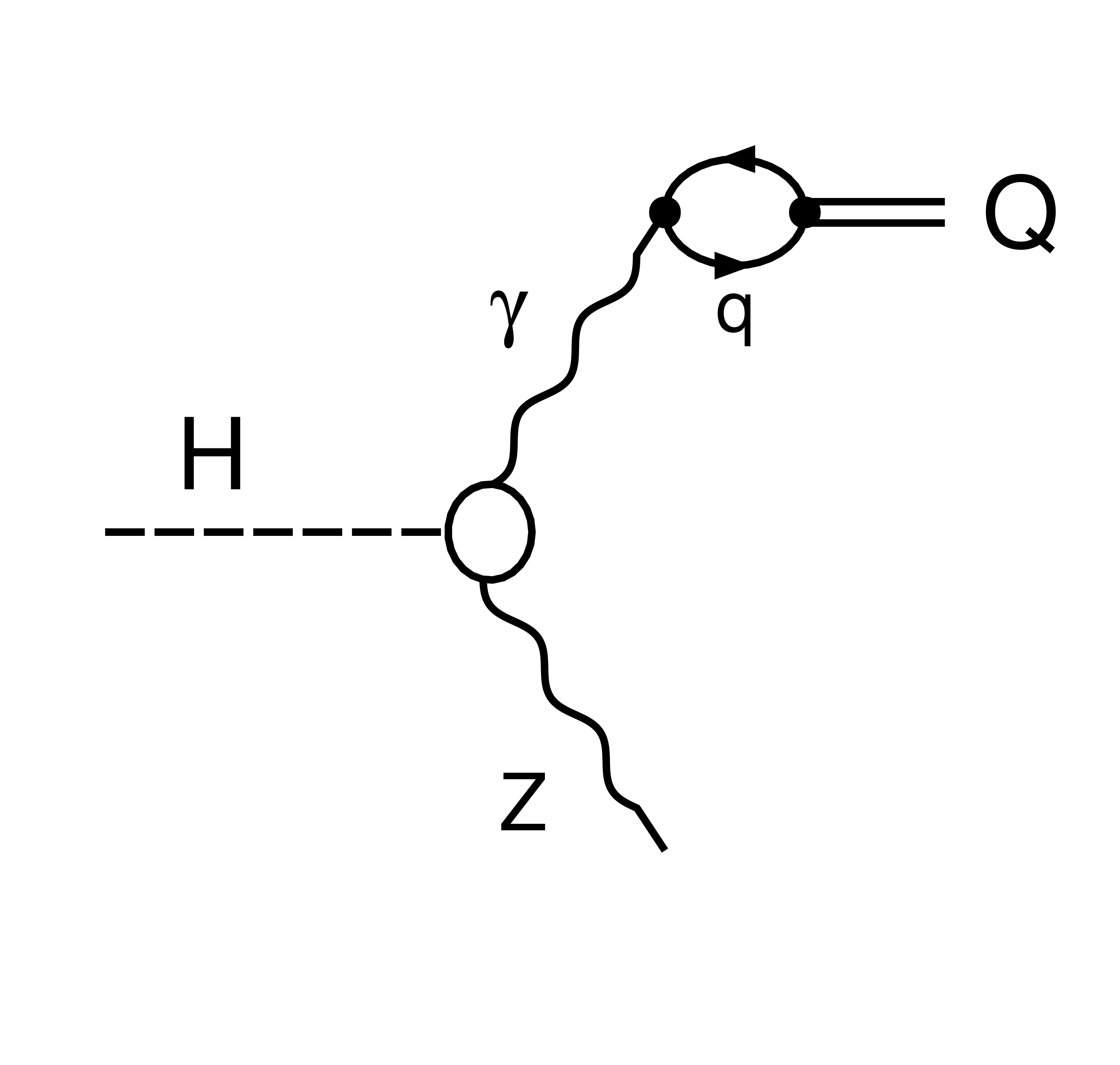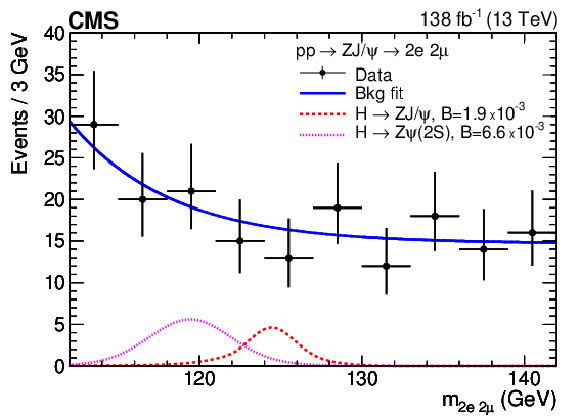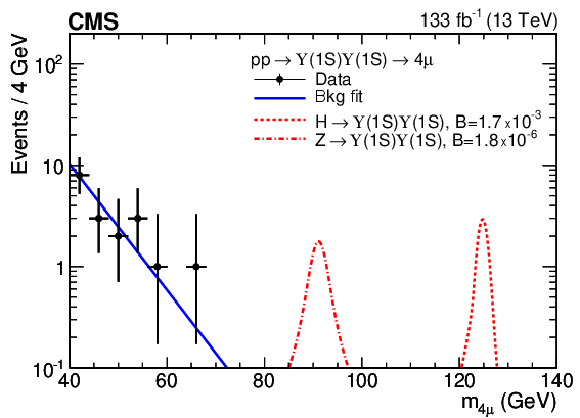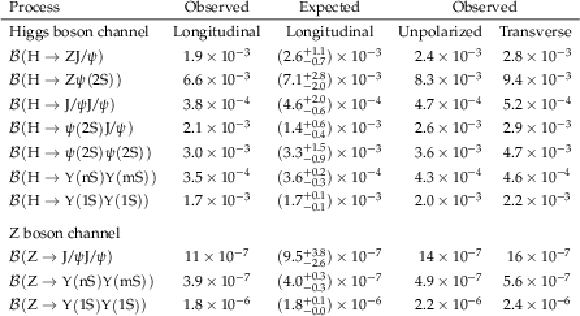

Compact Muon Solenoid
LHC, CERN
| CMS-HIG-20-008 ; CERN-EP-2022-074 | ||
| Search for Higgs boson decays into Z and J/$\psi$ and for Higgs and Z boson decays into J/$\psi$ or $\Upsilon$ pairs in pp collisions at $\sqrt{s} = $ 13 TeV | ||
| CMS Collaboration | ||
| 7 June 2022 | ||
| Phys. Lett. B 842 (2023) 137534 | ||
| Abstract: Decays of the Higgs boson into a Z boson and a J/$\psi$ or $\psi(\text{2S})$ meson are searched for in four-lepton final states with the CMS detector at the LHC. A data set of proton-proton collisions corresponding to an integrated luminosity of 138 fb$^{-1}$ is used. Using the same data set, decays of the Higgs and Z boson into quarkonium pairs are also searched for. An observation of such decays with this sample would indicate the presence of physics beyond the standard model. No evidence for these decays has been observed and upper limits at the 95% confidence level are placed on the corresponding branching fractions ($\mathcal{B}$). Assuming longitudinal polarization of the Higgs boson decay products, 95% confidence level observed upper limits for $\mathcal{B}(\mathrm{H}\to\mathrm{Z}\mathrm{J}/\psi)$ and $\mathcal{B}(\mathrm{H}\to\mathrm{Z}\psi(\text{2S}))$ are 1.9 $\times$ 10$^{-3}$ and 6.6 $\times$ 10$^{-3}$, respectively. | ||
| Links: e-print arXiv:2206.03525 [hep-ex] (PDF) ; CDS record ; inSPIRE record ; HepData record ; CADI line (restricted) ; | ||
| Figures | |

png pdf |
Figure 1:
Sample Feynman diagrams depicting direct (left) and indirect (middle, right) quark coupling contributions to the $\mathrm{H} \to \mathrm{Z} \mathrm {Q}$ decay, where $\mathrm {Q}$ represents a quarkonium and $\mathrm {q}$ is a quark. The diagrams represent Higgs boson decays into quarkonium pairs when replacing the bottom section with the upper half in each. |

png pdf |
Figure 1-a:
Sample Feynman diagram depicting direct quark coupling contributions to the $\mathrm{H} \to \mathrm{Z} \mathrm {Q}$ decay, where $\mathrm {Q}$ represents a quarkonium and $\mathrm {q}$ is a quark. |

png pdf |
Figure 1-b:
Sample Feynman diagram depicting indirect quark coupling contributions to the $\mathrm{H} \to \mathrm{Z} \mathrm {Q}$ decay, where $\mathrm {Q}$ represents a quarkonium and $\mathrm {q}$ is a quark. |

png pdf |
Figure 1-c:
Sample Feynman diagram depicting indirect quark coupling contributions to the $\mathrm{H} \to \mathrm{Z} \mathrm {Q}$ decay, where $\mathrm {Q}$ represents a quarkonium and $\mathrm {q}$ is a quark. |

png pdf |
Figure 2:
Four-lepton invariant mass distributions, (left) for $\mathrm{Z} {\mathrm{J}/\psi} \to 4\mu $ candidates and (right) for $\mathrm{Z} {\mathrm{J}/\psi} \to 2\mathrm{e} 2\mu $ candidates. The result of the maximum likelihood fit to the background (Bkg) is superimposed (solid blue line). For illustrative purposes, the plots show simulated $\mathrm{H} \to \mathrm{Z} {\mathrm{J}/\psi} $ (dashed red line) and $\mathrm{H} \to \mathrm{Z} \psi(\text{2S})$ (dotted magenta line) signals normalized to their observed upper limit branching fractions at 95% CL as obtained in this analysis, where $\psi(\text{2S})$ decays into ${\mathrm{J}/\psi} $+X. |

png pdf |
Figure 2-a:
Four-lepton invariant mass distribution for $\mathrm{Z} {\mathrm{J}/\psi} \to 4\mu $ candidates. The result of the maximum likelihood fit to the background (Bkg) is superimposed (solid blue line). For illustrative purposes, the plot shows simulated $\mathrm{H} \to \mathrm{Z} {\mathrm{J}/\psi} $ (dashed red line) and $\mathrm{H} \to \mathrm{Z} \psi(\text{2S})$ (dotted magenta line) signals normalized to their observed upper limit branching fractions at 95% CL as obtained in this analysis, where $\psi(\text{2S})$ decays into ${\mathrm{J}/\psi} $+X. |

png pdf |
Figure 2-b:
Four-lepton invariant mass distribution for $\mathrm{Z} {\mathrm{J}/\psi} \to 2\mathrm{e} 2\mu $ candidates. The result of the maximum likelihood fit to the background (Bkg) is superimposed (solid blue line). For illustrative purposes, the plot shows simulated $\mathrm{H} \to \mathrm{Z} {\mathrm{J}/\psi} $ (dashed red line) and $\mathrm{H} \to \mathrm{Z} \psi(\text{2S})$ (dotted magenta line) signals normalized to their observed upper limit branching fractions at 95% CL as obtained in this analysis, where $\psi(\text{2S})$ decays into ${\mathrm{J}/\psi} $+X. |

png pdf |
Figure 3:
The four-muon invariant mass distribution of ${\mathrm{J}/\psi} {\mathrm{J}/\psi} $ candidates (error bars for empty bins are not shown). The result of the maximum likelihood fit to the background (Bkg) is superimposed (solid blue line). For illustrative purposes, the plots show the distributions for simulated signals of the Higgs and Z boson decaying into ${\mathrm{J}/\psi} {\mathrm{J}/\psi} $ (dashed and dashed-dotted red lines). The signals for the Higgs boson decays $\mathrm{H} \to \psi(\text{2S}){\mathrm{J}/\psi} $ (dotted magenta line) and $\mathrm{H} \to \psi(\text{2S})\psi(\text{2S})$ (dashed-dotted black line) are also shown, where $\psi(\text{2S})$ decays into ${\mathrm{J}/\psi}$. Each signal is normalized to their observed 95% CL upper limit branching fraction from this analysis. |

png pdf |
Figure 4:
The four-muon invariant mass distributions for $\Upsilon(\text{nS})\Upsilon(\text{mS})$ (left) and $\Upsilon(\text{1S})\Upsilon(\text{1S})$ (right) candidates (error bars for empty bins are not shown). The result of the maximum likelihood fit to background (Bkg) is superimposed (solid blue line). For illustrative purposes, the plots show the distributions for simulated Higgs and Z boson signals (dashed and dashed-dotted red lines) normalized to their observed 95% CL upper limit branching fractions from this analysis. |

png pdf |
Figure 4-a:
The four-muon invariant mass distribution for $\Upsilon(\text{nS})\Upsilon(\text{mS})$ candidates (error bars for empty bins are not shown). The result of the maximum likelihood fit to background (Bkg) is superimposed (solid blue line). For illustrative purposes, the plot shows the distributions for simulated Higgs and Z boson signals (dashed and dashed-dotted red lines) normalized to their observed 95% CL upper limit branching fractions from this analysis. |

png pdf |
Figure 4-b:
The four-muon invariant mass distribution for $\Upsilon(\text{1S})\Upsilon(\text{1S})$ candidates (error bars for empty bins are not shown). The result of the maximum likelihood fit to background (Bkg) is superimposed (solid blue line). For illustrative purposes, the plot shows the distributions for simulated Higgs and Z boson signals (dashed and dashed-dotted red lines) normalized to their observed 95% CL upper limit branching fractions from this analysis. |
| Tables | |

png pdf |
Table 1:
Exclusion limits at 95% CL on the branching fractions of the H and Z boson decays. The second column lists the observed limits for the case that both intermediate particles are longitudinally polarized ($\lambda _\theta = -$1) as described in the text. The third column shows the median expected limits with the upper and lower bounds in the expected 68% CL intervals. The last two columns list observed upper limits for unpolarized ($\lambda _\theta = $ 0) and transversely polarized ($\lambda _\theta = +$1) intermediate particles. |
| Summary |
| This Letter presents the first search for decays of the Higgs boson (H) into a Z boson and a J/$\psi$ meson in four-lepton final states. Data from proton-proton collisions at $\sqrt{s} = $ 13 TeV, corresponding to an integrated luminosity of about 138 fb$^{-1}$, are used. Using the same data, decays of the Higgs and Z boson into quarkonium pairs are also searched for. No excess of a Higgs or Z boson signal above background is found in any of the searched channels and upper limits on branching fractions ($\mathcal{B}$) at the 95% confidence level for various polarization scenarios are set. The Higgs boson decay is also searched for in channels where, before decaying into muon pairs, one or both J/$\psi$ mesons could be the result of an inclusive $\psi(\text{2S})$ to J/$\psi$ transition, and the $\Upsilon(\text{nS}) (\mathrm{n}=1,2)$ mesons could be the result of inclusive transitions from $\Upsilon(\text{nS}) (\mathrm{n}=2,3)$ mesons. The observed upper limits for the Higgs and Z boson decays for longitudinally polarized mesons are $\mathcal{B}(\mathrm{H}\to\mathrm{Z}\mathrm{J}/\psi) < $ 1.9 $\times$ 10$^{-3}$, $\mathcal{B}(\mathrm{H}\to\mathrm{Z}\psi(\text{2S})) < $ 6.6 $\times$ 10$^{-3}$, $\mathcal{B}(\mathrm{H}\to\mathrm{J}/\psi\mathrm{J}/\psi) < $ 3.8 $\times$ 10$^{-4}$, $\mathcal{B}(\mathrm{H}\to\psi(\text{2S})\mathrm{J}/\psi) < $ 2.1 $\times$ 10$^{-3}$, $\mathcal{B}(\mathrm{H}\to\psi(\text{2S})\psi(\text{2S})) < $ 3.0 $\times$ 10$^{-3}$, $\mathcal{B}(\mathrm{H}\to\Upsilon(\text{nS})\Upsilon(\text{mS})) < $ 3.5 $\times$ 10$^{-4}$, $\mathcal{B}(\mathrm{H}\to\Upsilon(\text{1S})\Upsilon(\text{1S})) < $ 1.7 $\times$ 10$^{-3}$, $\mathcal{B}(\mathrm{Z}\to\mathrm{J}/\psi\mathrm{J}/\psi) < $ 11 $\times$ 10$^{-7}$, $\mathcal{B}(\mathrm{Z}\to\Upsilon(\text{nS})\Upsilon(\text{mS})) < $ 3.9 $\times$ 10$^{-7}$, and $\mathcal{B}(\mathrm{Z}\to\Upsilon(\text{1S})\Upsilon(\text{1S})) < $ 1.8 $\times$ 10$^{-6}$. The observed upper limit branching fraction for $\mathrm{H}\to\mathrm{Z}\mathrm{J}/\psi$ is about 800 times the value predicted by the standard model [17,18,19]. For $\mathrm{H}\to\Upsilon(\text{nS})\Upsilon(\text{mS})$ the upper limit is about one order of magnitude higher than predicted by earlier standard model calculations [23]. |
| References | ||||
| 1 | ATLAS Collaboration | Observation of a new particle in the search for the standard model Higgs boson with the ATLAS detector at the LHC | PLB 716 (2012) 1 | 1207.7214 |
| 2 | CMS Collaboration | Observation of a new boson at a mass of 125 GeV with the CMS experiment at the LHC | PLB 716 (2012) 30 | CMS-HIG-12-028 1207.7235 |
| 3 | CMS Collaboration | Observation of a new boson with mass near 125 GeV in pp collisions at $ \sqrt{s} = $ 7 and 8 TeV | JHEP 06 (2013) 081 | CMS-HIG-12-036 1303.4571 |
| 4 | ATLAS and CMS Collaborations | Combined measurement of the Higgs boson mass in pp collisions at $ \sqrt{s} = $ 7 and 8 TeV with the ATLAS and CMS experiments | PRL 114 (2015) 191803 | 1503.07589 |
| 5 | ATLAS and CMS Collaborations | Measurements of the Higgs boson production and decay rates and constraints on its couplings from a combined ATLAS and CMS analysis of the LHC pp collision data at $ \sqrt{s}= $ 7 and 8 TeV | JHEP 08 (2016) 45 | 1606.02266 |
| 6 | CMS Collaboration | Combined measurements of the Higgs boson's couplings at $ \sqrt{s} = $ 13 TeV | EPJC 79 (2019) 421 | CMS-HIG-17-031 1809.10733 |
| 7 | LHC Higgs Cross Section Working Group | Handbook of LHC Higgs cross sections: 4. Deciphering the nature of the Higgs sector | CERN-2017-002-M | 1610.07922 |
| 8 | G. F. Giudice and O. Lebedev | Higgs-dependent Yukawa couplings | PLB 665 (2008) 79 | 0804.1753 |
| 9 | D. Egana-Ugrinovic, S. Homiller, and P. R. Meade | Higgs bosons with large couplings to light quarks | PRD 100 (2019) 115041 | 1908.11376 |
| 10 | C. D. Froggatt and H. B. Nielsen | Hierarchy of quark masses, Cabibbo angles and CP violation | NPB 147 (1979) 277 | |
| 11 | L. Randall and R. Sundrum | A large mass hierarchy from a small extra dimension | PRL 83 (1999) 3370 | hep-ph/9905221 |
| 12 | S. J. Huber and Q. Shafi | Fermion masses, mixings and proton decay in a Randall-Sundrum model | PLB 498 (2001) 256 | hep-ph/0010195 |
| 13 | CMS Collaboration | Evidence for Higgs boson decay to a pair of muons | JHEP 01 (2021) 148 | CMS-HIG-19-006 2009.04363 |
| 14 | ATLAS Collaboration | A search for the dimuon decay of the standard model Higgs boson with the ATLAS detector | PLB 812 (2021) 135980 | 2007.07830 |
| 15 | ATLAS Collaboration | Direct constraint on the Higgs-charm coupling from a search for Higgs boson decays into charm quarks with the ATLAS detector | 2022. Submitted to EPJC | 2201.11428 |
| 16 | CMS Collaboration | Search for Higgs boson decay to a charm quark-antiquark pair in proton-proton collisions at $ \sqrt{s} = $ 13 TeV | 2022. Submitted to PRLett | CMS-HIG-21-008 2205.05550 |
| 17 | S. Alte, M. Konig, and M. Neubert | Exclusive weak radiative Higgs decays in the standard model and beyond | JHEP 12 (2016) 037 | 1609.06310 |
| 18 | G. Isidori, A. V. Manohar, and M. Trott | Probing the nature of the Higgs-like boson via h $ \to $ VF decays | Phy. Lett. B 728 (2014) 131 | 1305.0663 |
| 19 | D.-N. Gao | A note on Higgs decays into Z boson and J/$\psi $ ($ \Upsilon $) | PLB 737 (2014) 366 | 1406.7102 |
| 20 | ATLAS Collaboration | Observation and measurements of the production of prompt and non-prompt J/$\psi $ mesons in association with a Z boson in pp collisions at $ \sqrt{s} = $ 8 TeV with the ATLAS detector | EPJC 75 (2015) 229 | 1412.6428 |
| 21 | ATLAS Collaboration | Search for Higgs boson decays into a Z boson and a light hadronically decaying resonance using 13 TeV pp collision data from the ATLAS detector | PRL 125 (2020) 221802 | 2004.01678 |
| 22 | CMS Collaboration | Search for decays of the 125 GeV Higgs boson into a Z boson and a $ \rho $ or $ \phi $ meson | JHEP 11 (2020) 039 | CMS-HIG-19-012 2007.05122 |
| 23 | M. Bander and A. Soni | Decays of Higgs scalars into vector mesons and photons | PLB 82 (1979) 411 | |
| 24 | W.-Y. Keung | Decay of the Higgs boson into heavy-quarkonium states | PRD 27 (1983) 2762 | |
| 25 | M. N. Doroshenko, V. G. Kartvelishvili, E. G. Chikovani, and S. M. Esakiya | Vector quarkonium in decays of heavy Higgs particles | Yad. Fiz. 46 (1987) 864 | |
| 26 | V. G. Kartvelishvili, E. G. Chikovani, and S. M. Esakiya | The production and decays of heavy quark bound states in strong and electroweak interactions. (in Russian) | Fiz. Elem. Chast. Atom. Yadra 19 (1988)139 | |
| 27 | V. Kartvelishvili, A. V. Luchinsky, and A. A. Novoselov | Double vector quarkonia production in exclusive Higgs boson decays | PRD 79 (2009) 114015 | 0810.0953 |
| 28 | G. T. Bodwin, F. Petriello, S. Stoynev, and M. Velasco | Higgs boson decays to quarkonia and the $ \mathrm{H}\mathrm{c\bar{c}} $ coupling | PRD 88 (2013) 053003 | 1306.5770 |
| 29 | Q.-L. Liao and J. Jiang | Excited heavy quarkonium production in Higgs boson decays | PRD 100 (2019) 053002 | 1908.01274 |
| 30 | CMS Collaboration | Search for Higgs and $ Z $ boson decays to J/$\psi $ or $ \Upsilon $ pairs in the four-muon final state in proton-proton collisions at $ \sqrt{s} = $ 13 TeV | PLB 797 (2019) 134811 | CMS-HIG-18-025 1905.10408 |
| 31 | A. L. Kagan et al. | Exclusive window onto Higgs Yukawa couplings | PRL 114 (2015) 101802 | 1406.1722 |
| 32 | CMS Collaboration | Search for rare decays of Z and Higgs bosons to J$ /\psi $ and a photon in proton-proton collisions at $ \sqrt{s} = $ 13 TeV | EPJC 79 (2019) 94 | CMS-SMP-17-012 1810.10056 |
| 33 | ATLAS Collaboration | Searches for exclusive Higgs and Z boson decays into $ \mathrm{J}/\psi\gamma $, $ \psi(\text{2S})\gamma $, and $ \psi(\text{2S})\gamma $ at $ \sqrt{s}= $ 13 TeV with the ATLAS detector | PLB 786 (2018) 134 | 1807.00802 |
| 34 | ATLAS Collaboration | Search for exclusive Higgs and Z boson decays to $ \phi\gamma $ and $ \rho\gamma $ with the ATLAS detector | JHEP 07 (2018) 127 | 1712.02758 |
| 35 | A. K. Likhoded and A. V. Luchinsky | Double charmonia production in exclusive Z boson decays | MPLA 33 (2018) 1850078 | 1712.03108 |
| 36 | CMS Collaboration | Observation of the $ \mathrm{Z} \rightarrow \psi \ell^+\ell^- $ decay in pp collisions at $ \sqrt{s} = $ 13 TeV | PRL 121 (2018) 141801 | CMS-BPH-16-001 1806.04213 |
| 37 | CMS Collaboration | The CMS experiment at the CERN LHC | JINST 3 (2008) S08004 | CMS-00-001 |
| 38 | CMS Tracker Group Collaboration | The CMS Phase-1 pixel detector upgrade | JINST 16 (2021) P02027 | 2012.14304 |
| 39 | CMS Collaboration | Performance of the CMS muon detector and muon reconstruction with proton-proton collisions at $ \sqrt{s} = $ 13 TeV | JINST 13 (2018) P06015 | CMS-MUO-16-001 1804.04528 |
| 40 | CMS Collaboration | Electron and photon reconstruction and identification with the CMS experiment at the CERN LHC | JINST 16 (2021) P05014 | CMS-EGM-17-001 2012.06888 |
| 41 | M. Cacciari, G. P. Salam, and G. Soyez | The anti-$ {k_{\mathrm{T}}} $ jet clustering algorithm | JHEP 04 (2008) 063 | 0802.1189 |
| 42 | M. Cacciari, G. P. Salam, and G. Soyez | Fastjet user manual | EPJC 72 (2012) 1896 | 1111.6097 |
| 43 | CMS Collaboration | Performance of the CMS level-1 trigger in proton-proton collisions at $ \sqrt{s} = $ 13 TeV | JINST 15 (2020) P10017 | CMS-TRG-17-001 2006.10165 |
| 44 | CMS Collaboration | The CMS trigger system | JINST 12 (2017) P01020 | CMS-TRG-12-001 1609.02366 |
| 45 | R. Fruhwirth | Application of Kalman filtering to track and vertex fitting | NIMA 262 (1987) 444 | |
| 46 | S. Alioli, P. Nason, C. Oleari, and E. Re | NLO Higgs boson production via gluon fusion matched with shower in POWHEG | JHEP 04 (2009) 002 | 0812.0578 |
| 47 | P. Nason and C. Oleari | NLO Higgs boson production via vector-boson fusion matched with shower in POWHEG | JHEP 02 (2010) 037 | 0911.5299 |
| 48 | NNPDF Collaboration | Parton distributions from high-precision collider data | EPJC 77 (2017) 663 | 1706.00428 |
| 49 | S. Bolognesi et al. | On the spin and parity of a single-produced resonance at the LHC | PRD 86 (2012) 095031 | 1208.4018 |
| 50 | A. V. Gritsan, R. Rontsch, M. Schulze, and M. Xiao | Constraining anomalous Higgs boson couplings to the heavy flavor fermions using matrix element techniques | PRD 94 (2016) 055023 | 1606.03107 |
| 51 | T. Sjostrand et al. | An introduction to PYTHIA 8.2 | CPC 191 (2015) 159 | 1410.3012 |
| 52 | CMS Collaboration | Event generator tunes obtained from underlying event and multiparton scattering measurements | EPJC 76 (2016) 155 | CMS-GEN-14-001 1512.00815 |
| 53 | CMS Collaboration | Measurement of inclusive W and Z boson production cross sections in pp collisions at $ \sqrt{s} = $ 13 TeV | CMS-PAS-SMP-15-004 | CMS-PAS-SMP-15-004 |
| 54 | Y. Li and F. Petriello | Combining QCD and electroweak corrections to dilepton production in FEWZ | PRD 86 (2012) 094034 | 1208.5967 |
| 55 | J. Alwall et al. | The automated computation of tree-level and next-to-leading order differential cross sections, and their matching to parton shower simulations | JHEP 07 (2014) 079 | 1405.0301 |
| 56 | GEANT4 Collaboration | GEANT4--a simulation toolkit | NIMA 506 (2003) 250 | |
| 57 | P. Faccioli, C. Lourenço, J. Seixas, and H. K. Wohri | Towards the experimental clarification of quarkonium polarization | EPJC 69 (2010) 657 | 1006.2738 |
| 58 | S. Y. Choi | Z-boson polarization as a model-discrimination analyzer | PRD 98 (2018) 115037 | 1811.10377 |
| 59 | T. Junk | Confidence level computation for combining searches with small statistics | NIMA 434 (1999) 435 | hep-ex/9902006 |
| 60 | A. L. Read | Presentation of search results: The CL$ _{\text{s}} $ technique | JPG 28 (2002) 2693 | |
| 61 | ATLAS and CMS Collaborations, and LHC Higgs Combination Group | Procedure for the LHC Higgs boson search combination in Summer 2011 | CMS-NOTE-2011-005 | |
| 62 | J. R. Klein and A. Roodman | Blind analysis in nuclear and particle physics | Ann. Rev. Nucl. Part. Sci. 55 (2005) 141 | |
| 63 | CMS Collaboration | Measurement of the inclusive W and Z production cross sections in pp collisions at $ \sqrt{s} = $ 7 TeV | JHEP 10 (2011) 132 | CMS-EWK-10-005 1107.4789 |
| 64 | W. Verkerke and D. P. Kirkby | The RooFit toolkit for data modeling | in Proceedings of the 13th International Conference for Computing in High-Energy and Nuclear Physics (CHEP03) 2003 [eConf C0303241, MOLT007] | physics/0306116 |
| 65 | M. J. Oreglia | A study of the reactions $\psi' \to \gamma\gamma \psi$ | PhD thesis, Stanford University, 1980 SLAC Report SLAC-R-236, see Appendix D | |
| 66 | Particle Data Group | Review of Particle Physics | PTEP 2020 (2020) 083C01 | |
| 67 | CMS Collaboration | Precision luminosity measurement in proton-proton collisions at $ \sqrt{s} = $ 13 TeV in 2015 and 2016 at CMS | EPJC 81 (2021) 800 | CMS-LUM-17-003 2104.01927 |
| 68 | CMS Collaboration | CMS luminosity measurement for the 2017 data-taking period at $ \sqrt{s}= $ 13 TeV | CMS-PAS-LUM-17-004 | CMS-PAS-LUM-17-004 |
| 69 | CMS Collaboration | CMS luminosity measurement for the 2018 data-taking period at $ \sqrt{s}= $ 13 TeV | CMS-PAS-LUM-18-002 | CMS-PAS-LUM-18-002 |
| 70 | J. Butterworth et al. | PDF4LHC recommendations for LHC Run II | JPG 43 (2016) 023001 | 1510.03865 |
| 71 | A. D. Martin, W. J. Stirling, R. S. Thorne, and G. Watt | Parton distributions for the LHC | EPJC 63 (2009) 189 | 0901.0002 |
| 72 | H. L. Lai et al. | New parton distributions for collider physics | PRD 82 (2010) 74024 | 1007.2241 |
| 73 | NNPDF Collaboration | Impact of heavy quark masses on parton distributions and LHC phenomenology | NPB 849 (2011) 296 | 1101.1300 |
| 74 | CMS Collaboration | HEPData record for this analysis | link | |

|
Compact Muon Solenoid LHC, CERN |

|

|

|

|

|

|